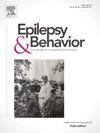颞叶癫痫患者言语流利任务后半期代偿性模块间功能连通性增强
IF 2.3
3区 医学
Q2 BEHAVIORAL SCIENCES
引用次数: 0
摘要
先前的研究表明,语言子系统之间的动态相互作用被破坏会降低颞叶癫痫(TLE)患者对变化的认知负荷的适应能力。然而,如何动态地执行交互仍然不清楚。由于汉字的图形音节符号特性,汉字言语流畅性(VFC)任务在整个任务过程中提供了变化的需求,是分析语言子系统动态交互的理想工具。方法从正在进行的队列中选取29例神经正常对照和58例TLE患者参与本研究。在参与者完成汉语口语流利性任务时,收集功能性MRI数据。比较对照组和患者从任务块的前半部分到后半部分的功能连接改变。功能连通性发生重大变化的区域被聚类成模块。采用滑动窗口法计算模块的招募和积分,并进行了比较。结果我们捕获了左额叶和前颞叶模块。在VFC任务的后半部分,患者左额叶和颞叶前部模块之间的功能连通性得到增强,而对照组则没有(p <;0.05, FDR-corrected)。同时,TLE在颞叶前部模块内的功能连通性在整个任务过程中受到损害(p = 0.04),并且患者的两个模块更整合(p = 0.008)。患者的模块间连通性增强与更好的语言流畅性表现相关(p = 0.03,经fdr校正)。结论:我们观察到TLE患者的模内动态功能连接减弱,模间动态功能连接增强。任务后半部分增强的模块间功能连通性代表了一个补偿过程,这是TLE语言衰退的潜在干预目标。本文章由计算机程序翻译,如有差异,请以英文原文为准。

Compensative inter-module functional connectivity enhancement at the latter half of verbal fluency task in patients with temporal lobe epilepsy
Background
Previous studies proposed that disrupted dynamic interaction between language subsystems diminishes temporal lobe epilepsy (TLE) patients’ adaptability to changing cognitive loads. However, how the interaction is dynamically performed remained unclear. Due to the graphic syllabic logographic nature of Chinese characters, the Chinese Character verbal fluency (VFC) task provides changing demands throughout the task, being an ideal tool to analyze the dynamic interaction of language subsystems.
Methods
Twenty-nine neurotypical controls and 58 patients with TLE from an ongoing cohort participated in this study. Functional MRI data was collected while participants performed a Chinese verbal fluency task. Functional connectivity alteration from the first to the second half of the task block were compared between controls and patients. Regions with significant functional connectivity changes are clustered into modules. The recruitment and integration of modules were calculated with sliding-window approaches and compared.
Results
We captured the left frontal and anterior temporal lobe modules. The functional connectivity between the left frontal and anterior temporal modules was enhanced in the latter half of the VFC task in patients but not controls (p < 0.05, FDR-corrected). Meanwhile, TLE’s functional connectivity within the anterior temporal module was impaired throughout the task (p = 0.04), and the two modules were more integrated in patients (p = 0.008). Intermodular connectivity enhancement in patients was correlated with better verbal fluency performance (p = 0.03, FDR-corrected).
Conclusion
We observed diminished intramodular and enhanced intermodular dynamic functional connectivity in patients with TLE. The enhanced intermodular functional connectivity at the latter half of the task represents a compensative process, a potential intervention target for language decline in TLE.
求助全文
通过发布文献求助,成功后即可免费获取论文全文。
去求助
来源期刊

Epilepsy & Behavior
医学-行为科学
CiteScore
5.40
自引率
15.40%
发文量
385
审稿时长
43 days
期刊介绍:
Epilepsy & Behavior is the fastest-growing international journal uniquely devoted to the rapid dissemination of the most current information available on the behavioral aspects of seizures and epilepsy.
Epilepsy & Behavior presents original peer-reviewed articles based on laboratory and clinical research. Topics are drawn from a variety of fields, including clinical neurology, neurosurgery, neuropsychiatry, neuropsychology, neurophysiology, neuropharmacology, and neuroimaging.
From September 2012 Epilepsy & Behavior stopped accepting Case Reports for publication in the journal. From this date authors who submit to Epilepsy & Behavior will be offered a transfer or asked to resubmit their Case Reports to its new sister journal, Epilepsy & Behavior Case Reports.
 求助内容:
求助内容: 应助结果提醒方式:
应助结果提醒方式:


